Astrophysical signatures of exact anisotropic stellar solutions: Dynamics of two pulsars within the context of Rastall theory
IF 2.8
3区 物理与天体物理
Q2 PHYSICS, PARTICLES & FIELDS
引用次数: 0
Abstract
This study proposes a couple of analytical solutions that characterize the anisotropic dense celestial bodies within the Rastall theoretical framework. The analysis presumes a spherically symmetric matter arrangement under which the system of gravitational equations is derived. By utilizing well-established radial metric functions and merging them with the two principal pressures, we obtain differential equations related to component. Subsequently, we perform the integration of these equations to determine the remaining geometric quantity that encompasses various integration constants. The proposed interior solutions are then matched with the Schwarzschild exterior metric at the boundary of the compact object, facilitating the determination of the constants. Additionally, the incorporation of the non-minimal coupling parameter into these constants is accomplished by enforcing the null radial pressure at the boundary. Afterwards, we rigorously examine the physical characteristics and critical stability conditions of the formulated models under observational data from two pulsars, say LMC X-4 and 4U 1820-30. It is concluded that our models are well-aligned with essential criteria required to ensure the physical viability of stellar structures, subject to specific parametric values.
精确各向异性恒星解的天体物理特征:拉斯托理论背景下两颗脉冲星的动力学
本研究提出了在拉斯托理论框架内表征各向异性致密天体的两个解析解。该分析假定了一种球对称的物质排列,在这种排列下导出了引力方程组。通过利用已建立的径向度量函数并将其与两个主压力合并,我们得到了与gtt分量相关的微分方程。随后,我们对这些方程进行积分,以确定包含各种积分常数的剩余几何量。然后将所提出的内部解与致密物体边界处的史瓦西外部度规相匹配,便于确定常数。此外,将非最小耦合参数纳入这些常数是通过在边界处施加零径向压力来实现的。随后,我们在LMC X-4和4U 1820-30两颗脉冲星的观测数据下严格检验了所建立模型的物理特性和临界稳定性条件。结论是,我们的模型与确保恒星结构在特定参数值下的物理可行性所需的基本标准非常一致。
本文章由计算机程序翻译,如有差异,请以英文原文为准。
求助全文
约1分钟内获得全文
求助全文
来源期刊

Nuclear Physics B
物理-物理:粒子与场物理
CiteScore
5.50
自引率
7.10%
发文量
302
审稿时长
1 months
期刊介绍:
Nuclear Physics B focuses on the domain of high energy physics, quantum field theory, statistical systems, and mathematical physics, and includes four main sections: high energy physics - phenomenology, high energy physics - theory, high energy physics - experiment, and quantum field theory, statistical systems, and mathematical physics. The emphasis is on original research papers (Frontiers Articles or Full Length Articles), but Review Articles are also welcome.
 求助内容:
求助内容: 应助结果提醒方式:
应助结果提醒方式:


